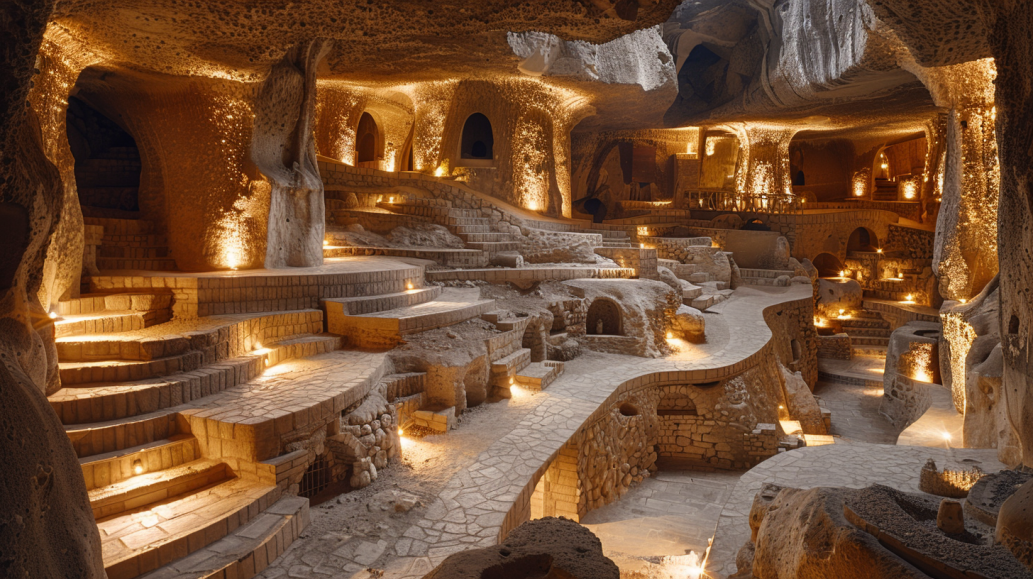Introduction
The Derinkuyu Underground City is one of the most fascinating and enigmatic archaeological sites in the world. Hidden beneath the Cappadocia region of Turkey, this sprawling underground complex could once house up to 20,000 people. Built during the Byzantine era, the true purpose of Derinkuyu remains a topic of debate among historians and archaeologists. Was it a refuge from invaders, a monastic sanctuary, or something else entirely? The secrets of Derinkuyu continue to captivate researchers and visitors alike.
Discovery of Derinkuyu
The Derinkuyu Underground City was accidentally discovered in 1963 when a local resident stumbled upon a hidden room behind a wall in his basement. Further exploration revealed a vast network of tunnels and chambers extending deep into the earth. This remarkable find sparked immediate interest and led to extensive archaeological investigations.
Description of the City
Derinkuyu is an intricate maze of tunnels, chambers, and passages spanning multiple levels underground. The city includes living quarters, communal spaces, storage rooms, stables, and even places of worship. Narrow passageways connect the various levels, and stone doors could be rolled into place to seal off sections of the city for protection.
Historical Background
The construction of Derinkuyu dates back to the Byzantine era, a time marked by frequent invasions and conflicts. The region of Cappadocia was strategically important and often subject to attacks, which may have prompted the construction of such elaborate underground refuges.
Purpose of Derinkuyu
The true purpose of Derinkuyu remains a mystery, with several theories proposed by historians and archaeologists. Some suggest it was built as a refuge from invaders, while others believe it served as a monastic sanctuary or a combination of both. The complexity and scale of the city indicate it played a significant role in the lives of its inhabitants.
Refuge from Invaders
One of the most compelling theories is that Derinkuyu was constructed as a shelter from invaders. The city’s design, with its narrow tunnels and strategically placed stone doors, supports this idea. These features would have allowed inhabitants to defend themselves and survive prolonged periods underground.
Monastic Sanctuary
Another theory posits that Derinkuyu served as a monastic sanctuary. The presence of chapels and religious symbols suggests that the underground city could have been a place of refuge for monks and other religious figures seeking solitude and protection.
Architectural Marvels
Derinkuyu is an architectural marvel, showcasing the ingenuity and resourcefulness of its builders. The city’s layout includes vertical shafts for ventilation, a complex system of wells for water supply, and sophisticated storage facilities to preserve food.
Daily Life in Derinkuyu
Life in Derinkuyu would have been challenging but well-organized. The city contained everything needed to sustain its inhabitants, including communal kitchens, wineries, and even a school. Daily activities would have revolved around maintaining the city’s infrastructure and ensuring the well-being of its residents.
Water and Ventilation Systems
One of the most impressive aspects of Derinkuyu is its advanced water and ventilation systems. Vertical shafts provided fresh air to the deepest levels of the city, while an extensive network of wells ensured a reliable water supply. These systems were crucial for sustaining life underground.
Comparison with Other Underground Cities
Derinkuyu is not unique; Cappadocia is home to several other underground cities, such as Kaymakli and Özkonak. These cities share similar architectural features and likely served similar purposes. Comparing these sites provides valuable insights into the region’s history and the strategies used by its inhabitants to survive.
Current Excavations
Archaeological excavations at Derinkuyu are ongoing, with new discoveries being made regularly. Researchers continue to explore the city’s depths, uncovering artifacts and gaining a better understanding of its construction and use.
Cultural Impact
Derinkuyu has had a significant impact on local culture and tourism. The underground city attracts thousands of visitors each year, drawn by its mystery and historical significance. It has also inspired numerous books, documentaries, and studies.
Legends and Myths
Derinkuyu is shrouded in legends and myths. Some local folklore suggests the city was built by giants or other mythical beings. These stories add to the allure of Derinkuyu and reflect the deep sense of wonder it inspires.
Conclusion
The Derinkuyu Underground City remains one of history’s greatest enigmas. Its construction, purpose, and the lives of those who inhabited it continue to intrigue researchers and visitors alike. As excavations and studies continue, we may one day uncover the full story of this remarkable subterranean world.
FAQs
Q: How was the Derinkuyu Underground City discovered?
A: It was discovered in 1963 by a local resident who found a hidden room behind a wall in his basement.
Q: What is the purpose of the Derinkuyu Underground City?
A: The exact purpose is unknown, but theories include it being a refuge from invaders or a monastic sanctuary.
Q: How many people could the Derinkuyu Underground City accommodate?
A: The city could house up to 20,000 people.
Q: Are there other underground cities like Derinkuyu?
A: Yes, there are several other underground cities in Cappadocia, such as Kaymakli and Özkonak.
Q: Can visitors explore the Derinkuyu Underground City?
A: Yes, the site is open to visitors and is a popular tourist attraction.

